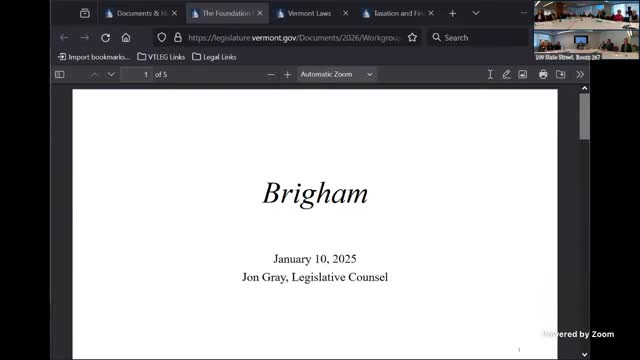Legislative counsel reviews Brigham decision: state must ensure substantial equality of educational opportunity, but court left methods to legislature
January 11, 2025 | Ways & Means, HOUSE OF REPRESENTATIVES, Committees, Legislative , Vermont
This article was created by AI summarizing key points discussed. AI makes mistakes, so for full details and context, please refer to the video of the full meeting. Please report any errors so we can fix them. Report an error »

John Gray of the Office of Legislative Council told the joint House Ways and Means and Senate Finance hearing that the 1997 Brigham decision remains the legal foundation for much of Vermont’s education finance policy.
Gray summarized the court’s finding that the prior ‘‘foundation plan’’ — which relied heavily on local property taxes — produced wide disparities in revenues available to local school districts and therefore ‘‘deprive[d] children of an equal educational opportunity’’ under the Vermont Constitution. He said the court held that the state must ‘‘ensure substantial equality of educational opportunity throughout Vermont,’’ but it did not dictate the specific funding mechanism the legislature must use to meet that obligation.
Gray explained the decision rested on two constitutional provisions: the Education Clause (which the court treated as recognizing a distinct, constitutionally protected right to education) and the Common Benefits Clause (an equal-protection–style guarantee). He emphasized that the court’s remedy was focused on eliminating systemic funding disparities produced by the state’s prior reliance on local property wealth rather than specifying a single statutory fix.
Using an example from the foundation plan the court overturned, Gray described how two districts that both spend $10,000 per pupil could face very different local tax rates under a foundation-rate model. In his example a property-poor town would need to raise taxes substantially higher than a property-rich town to reach the same per-pupil spending, illustrating the court’s concern about unequal opportunity tied to local property wealth.
Gray cautioned that Brigham sets a legal requirement but not a clear numerical test: whether a proposed financing system satisfies Brigham is likely to be a fact-specific question that could ultimately require litigation to resolve. He told lawmakers that comparisons to the current system can skew the Brigham discussion because the case targeted a particular historical plan; a new financing approach need not be compared only to the modern system to assess compliance.
Committee members asked whether the court focused on outcomes for students; Gray answered that the decision centers on educational opportunity rather than guaranteeing particular outcomes and that the court recognized a ‘‘direct or quite clear connection between wealth and what was being spent on pupils.’’ He closed by saying the legislature retains discretion in choosing means to meet the constitutional directive and that further policy work will be necessary this session.
The joint committee indicated the Brigham background will inform upcoming policy debates as lawmakers and staff develop proposals and modeling for yields, tax rates and credits.
Gray summarized the court’s finding that the prior ‘‘foundation plan’’ — which relied heavily on local property taxes — produced wide disparities in revenues available to local school districts and therefore ‘‘deprive[d] children of an equal educational opportunity’’ under the Vermont Constitution. He said the court held that the state must ‘‘ensure substantial equality of educational opportunity throughout Vermont,’’ but it did not dictate the specific funding mechanism the legislature must use to meet that obligation.
Gray explained the decision rested on two constitutional provisions: the Education Clause (which the court treated as recognizing a distinct, constitutionally protected right to education) and the Common Benefits Clause (an equal-protection–style guarantee). He emphasized that the court’s remedy was focused on eliminating systemic funding disparities produced by the state’s prior reliance on local property wealth rather than specifying a single statutory fix.
Using an example from the foundation plan the court overturned, Gray described how two districts that both spend $10,000 per pupil could face very different local tax rates under a foundation-rate model. In his example a property-poor town would need to raise taxes substantially higher than a property-rich town to reach the same per-pupil spending, illustrating the court’s concern about unequal opportunity tied to local property wealth.
Gray cautioned that Brigham sets a legal requirement but not a clear numerical test: whether a proposed financing system satisfies Brigham is likely to be a fact-specific question that could ultimately require litigation to resolve. He told lawmakers that comparisons to the current system can skew the Brigham discussion because the case targeted a particular historical plan; a new financing approach need not be compared only to the modern system to assess compliance.
Committee members asked whether the court focused on outcomes for students; Gray answered that the decision centers on educational opportunity rather than guaranteeing particular outcomes and that the court recognized a ‘‘direct or quite clear connection between wealth and what was being spent on pupils.’’ He closed by saying the legislature retains discretion in choosing means to meet the constitutional directive and that further policy work will be necessary this session.
The joint committee indicated the Brigham background will inform upcoming policy debates as lawmakers and staff develop proposals and modeling for yields, tax rates and credits.
View the Full Meeting & All Its Details
This article offers just a summary. Unlock complete video, transcripts, and insights as a Founder Member.
✓
Watch full, unedited meeting videos
✓
Search every word spoken in unlimited transcripts
✓
AI summaries & real-time alerts (all government levels)
✓
Permanent access to expanding government content
30-day money-back guarantee
